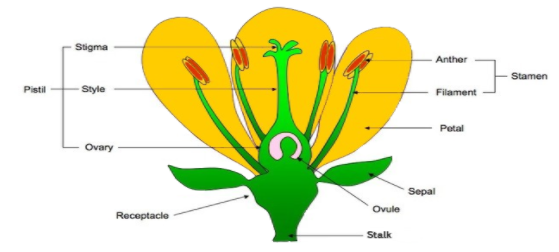
Name the parts of pistil which develop into fruit and seeds respectively.
Answer
490.2k+ views
Hint In plants the flower has many parts such as sepals, petals, stigma, anther, ovary, pistil etc. Pistil is the ovule producing part of the flower in which the ovary often supports a long style, tapped by stigma. In stigma pollen grain germinate and in ovary ovules are produced.
Complete answer: To answer this question you must know the fertilization of plants.
Flowers not only look pretty but, in fact, are very much important in making seeds and fruits. The flower has some basic parts such as sepals, petals and pistils.

Pistil is the female part of the flower located in the center of the flower and made up of three parts: stigma ,style and ovary. Stigma is the sticky knob at the top of the pistil. It is attached to the long tubelike structure called style and style leads to an ovary that contains the female eggs cells called ovules.
The male parts of the flower are called stamens, it is made up of two parts:- Anther and filament. The anther produces pollen or male reproductive cells and filament holds the anther up.
During the process of fertilization pollen reaches stigma ,a tube grows down the style and enters the ovary. Male reproductive cells reach down the tube and join to the ovule. After fertilization ovules become the seed and ovaries become the fruit.
Thus the name of the pistil is ovary where the development of fruits and seeds take place respectively.
Note: petals and sepals are also important parts of a flower, as they help to attract pollinators such as bees ,butterflies and bats. Sepals are tiny green leaf-like parts at the base of a flower, providing protection to the developing bud.
Complete answer: To answer this question you must know the fertilization of plants.
Flowers not only look pretty but, in fact, are very much important in making seeds and fruits. The flower has some basic parts such as sepals, petals and pistils.

Pistil is the female part of the flower located in the center of the flower and made up of three parts: stigma ,style and ovary. Stigma is the sticky knob at the top of the pistil. It is attached to the long tubelike structure called style and style leads to an ovary that contains the female eggs cells called ovules.
The male parts of the flower are called stamens, it is made up of two parts:- Anther and filament. The anther produces pollen or male reproductive cells and filament holds the anther up.
During the process of fertilization pollen reaches stigma ,a tube grows down the style and enters the ovary. Male reproductive cells reach down the tube and join to the ovule. After fertilization ovules become the seed and ovaries become the fruit.
Thus the name of the pistil is ovary where the development of fruits and seeds take place respectively.
Note: petals and sepals are also important parts of a flower, as they help to attract pollinators such as bees ,butterflies and bats. Sepals are tiny green leaf-like parts at the base of a flower, providing protection to the developing bud.
Recently Updated Pages
Master Class 12 Business Studies: Engaging Questions & Answers for Success

Master Class 12 Economics: Engaging Questions & Answers for Success

Master Class 12 English: Engaging Questions & Answers for Success

Master Class 12 Maths: Engaging Questions & Answers for Success

Master Class 12 Social Science: Engaging Questions & Answers for Success

Master Class 12 Chemistry: Engaging Questions & Answers for Success

Trending doubts
What is meant by exothermic and endothermic reactions class 11 chemistry CBSE

Which animal has three hearts class 11 biology CBSE

10 examples of friction in our daily life

One Metric ton is equal to kg A 10000 B 1000 C 100 class 11 physics CBSE

1 Quintal is equal to a 110 kg b 10 kg c 100kg d 1000 class 11 physics CBSE

Difference Between Prokaryotic Cells and Eukaryotic Cells




